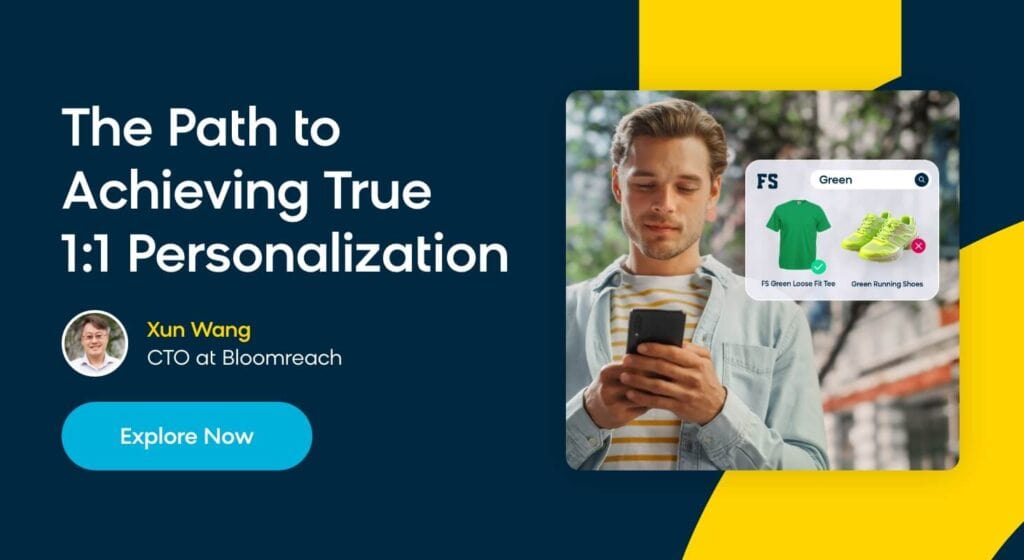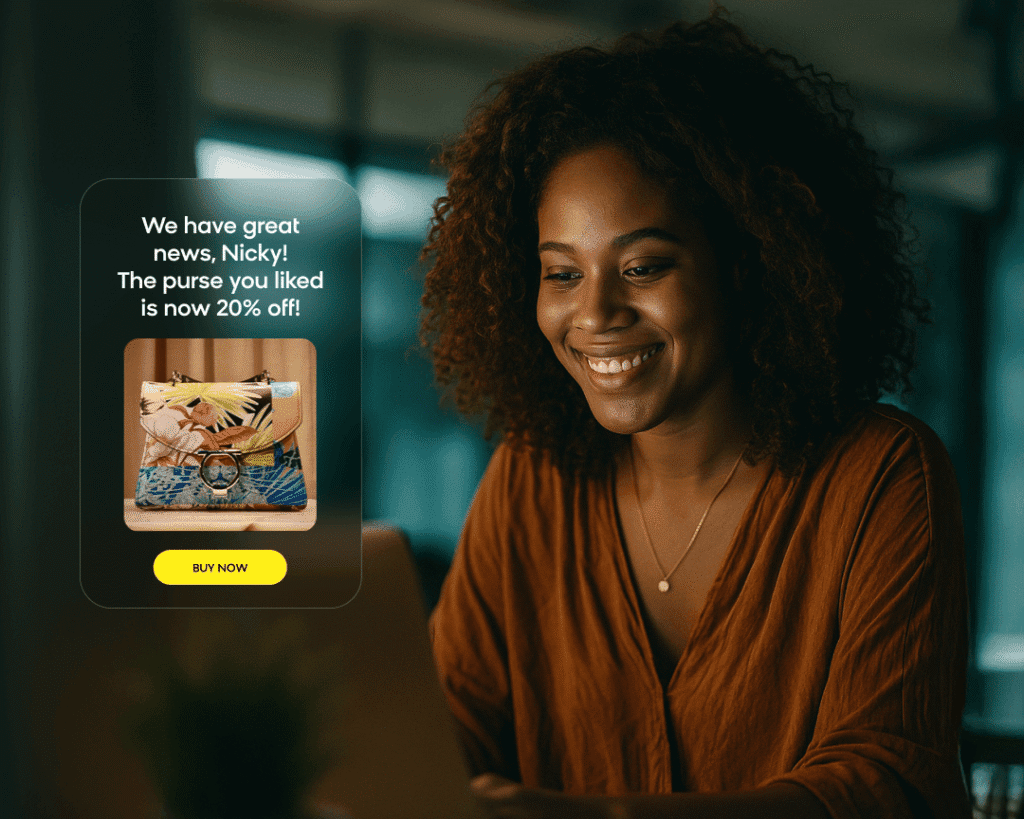Personalization is a word that’s been on everyone’s lips for years, and the appeal is easy to understand: It allows businesses to tailor their offerings to individual customer preferences, increasing engagement and loyalty while driving higher conversion rates and sales. But even though personalization is seen as the holy grail of the customer experience, it has been notoriously difficult to achieve in site search and product discovery, or at least in a way that’s effective for ecommerce and appreciated by shoppers. And it makes sense why — there are many obstacles against retailers and brands while orchestrating end-to-end personalization.
In particular, one big issue revolves around the ecommerce industry’s inflated focus on 1:1 personalization. Despite 1:1 personalization being considered the ideal type of ecommerce personalization, only 10-20% of your customers — those brand loyalists who shop with your business a few times a year — offer enough data to bring this approach to life.
So, what about the other 80-90% of shoppers?
Well, let’s remember personalization is not a feature — it’s a strategy. These numbers only reinforce the idea that personalization is multi-faceted, and not solely reliant on the customer profiles stored in your customer data platform (CDP). Your anonymous and semi-known visitors deserve as much attention as your loyal customers, particularly since brand loyalty is declining among younger generations like Gen-Z. In fact, 62% of Gen-Zers surveyed in the US and UK said they would check out other options for a new product or service, even if they have a favorite brand.
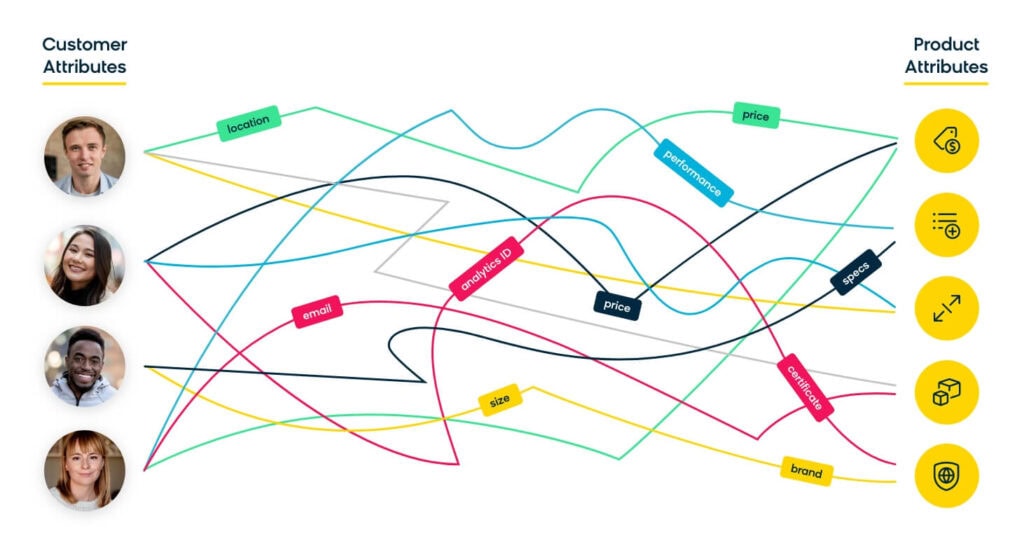
This underscores why a well-rounded personalization approach is more important than ever, despite its complexities. Before we explore how this strategy can enhance your search bar and the value it brings, let’s delve deeper into the common challenges of personalization.
3 Common Challenges With Personalization
As powerful as personalization can potentially be for businesses, it remains fairly ambiguous. This means that implementing an effective personalization strategy comes with its fair share of hurdles, including these three common challenges.
Customers Don’t Want To Share Personal Data
One of the biggest obstacles to personalization is a customer’s reluctance to share their personal data. With growing concerns over privacy and data security, customers are becoming more cautious about who they share their information with and how it’s used, especially with Google’s decision to scrap its plans to phase out the use of third-party cookies. Without access to personal data, however, it’s challenging for businesses to tailor their offerings and communications to preferences and behaviors, particularly at the individual level. This leads to generic, less effective merchandising (and marketing) strategies.
There’s Too Much Data To Put Into Action
Having large amounts of data doesn’t guarantee successful business outcomes. It’s not uncommon for businesses to find themselves overwhelmed by the sheer volume of information they collect. Even when businesses successfully collect and manage customer data, their teams often struggle to translate this information into actionable insights. The gap between data collection and data application can hinder the effectiveness of personalization strategies, resulting in disengagement and loss of loyalty.

Your Brand Doesn’t Have Cohesive Tools and Technologies
When it comes to ecommerce personalization, having tools and technologies that work well together is another significant hurdle. Personalization requires the seamless integration of various data sources, marketing automation platforms, and product search engines. However, many ecommerce businesses struggle with disparate systems that don’t communicate effectively, leading to fragmented customer data and inconsistent shopping experiences. This lack of cohesion can hinder the ability to deliver personalized content and recommendations in real time, diminishing the overall effectiveness of personalization efforts.
How You Can Use AI To Personalize Your Search Bar
Think of your search bar as an “in” to your customer’s innermost thoughts. It’s the place on your ecommerce website where they tell you exactly what they want to buy — or at least what they’re interested in exploring. Here’s how you can maximize AI for a more personalized shopping experience for all of your customers.
Unknown to Semi-Known Visitors
One of the most remarkable capabilities of AI is its ability to interpret customer intent in the search bar, even when it’s not explicitly stated. For example, if a shopper searches for “XXL yoga pants,” an AI-powered search bar can instantly present related products with photos of plus-sized models, offering a personalized touch without needing detailed information about the visitor.
This sophisticated level of personalization is possible thanks to advanced machine learning algorithms and natural language processing. Ultimately, AI-powered site search analyzes the context and nuances of search queries to understand the shopper’s underlying intent and preferences. It goes beyond simple keyword matching by considering factors like synonyms, customer behavior patterns, and semantic meaning, enabling the delivery of more relevant and tailored search results that align with the customer’s true needs. Then, as those shoppers take action (e.g., clicking on products they like and adding items to their cart), AI-powered search can tap into their interests and preferences and show them popular products among others with those same interests and preferences.
Defined Audience Segments
AI excels at analyzing clicks, browsing patterns, and comparing demographic data to deliver highly personalized recommendations. By tailoring search results based on factors like age, gender, or location, AI can identify and target audience segments based on shared characteristics or behaviors.
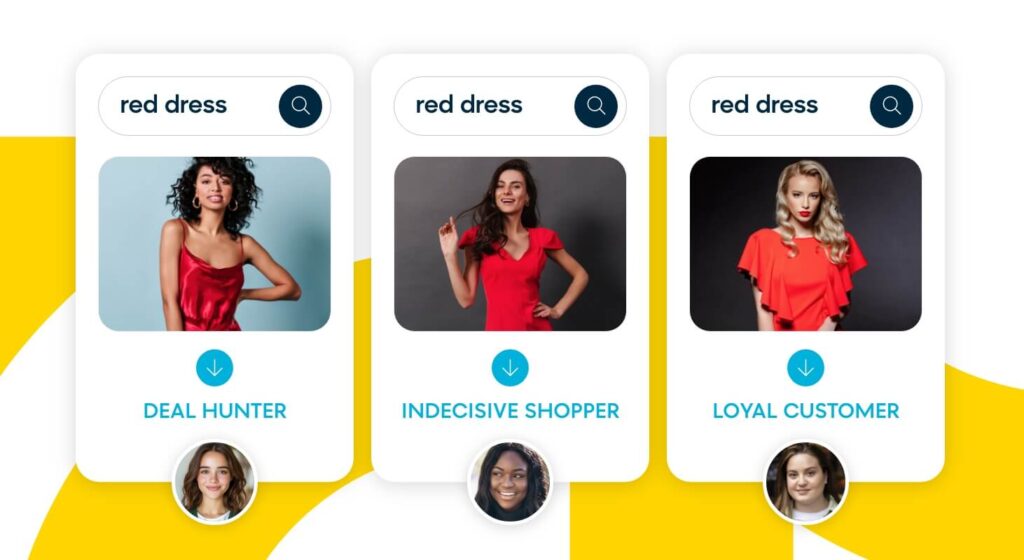
So, shoppers who frequently purchase high-end electronics might be grouped together and shown premium products or exclusive offers that bargain buyers wouldn’t receive. Such segmentation allows AI to prioritize relevant products and adapt to emerging trends and new customer segments. By continuously reevaluating search patterns and behaviors, AI ensures that your merchandising strategies align with evolving customer needs.
1:1 Individual Personalization
Finally, AI’s capabilities extend to delivering hyper-personalized experiences on an individual level. To approach 1:1 personalization effectively, it’s crucial to overcome challenges like edge cases and managing multiple affinities. Traditional methods often rely on single attributes and static settings, which lack depth. An advanced solution uses machine learning to relate products based on multiple affinities learned from customer interactions and product catalogs across categories and sessions, providing a richer, multi-dimensional understanding.
Automating affinity selection and ranking enhances accuracy through data-driven insights, treating each affinity as a signal and assigning optimal weights based on individual preferences. By prioritizing search intent over affinity, the results align more closely with what shoppers actually want. This adaptive approach merges various signals — like purchases, search intent, and reviews — to deliver personalized, relevant search results that evolve with each customer’s behavior and preferences.
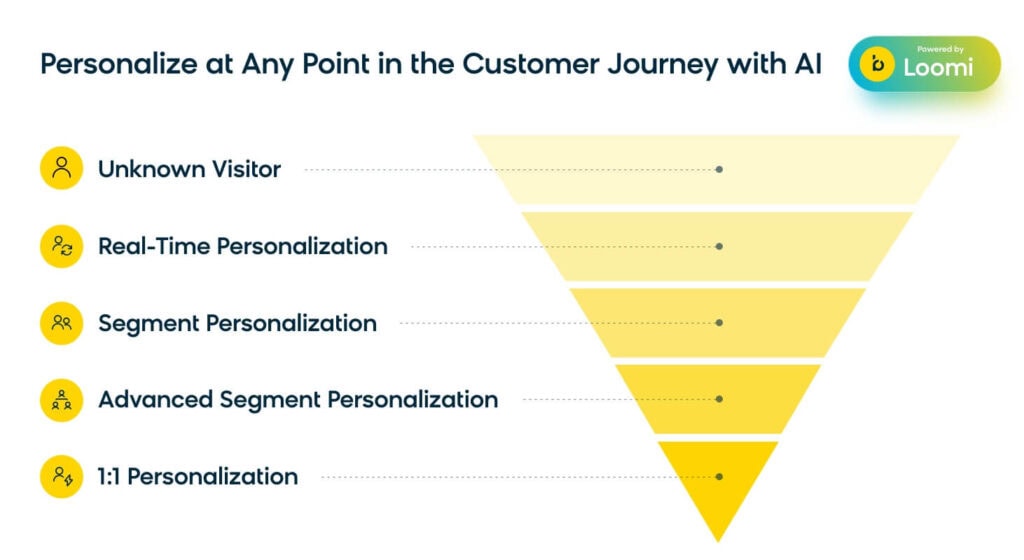
What Is the Value of AI-Powered Personalization?
Even though we’ve mainly focused on the search bar, AI-powered personalization can happen across the entire customer journey, from targeted marketing campaigns and dynamic pricing to shopping assistance and the checkout experience. Here’s why it’s meaningful to your brand.
Creating a Connected Customer Journey
AI-powered personalization ensures a connected customer journey, delivering relevant content and product recommendations at every touchpoint. This allows your brand to create a cohesive shopping experience that guides customers from discovery to purchase.
Creating Differentiation for Your Brand
In today’s saturated market, AI-powered personalization is essential for differentiation. By leveraging AI to deeply understand and anticipate customer needs, brands can offer tailored experiences that resonate on a profound level. Moreover, AI-driven personalization fosters long-term customer loyalty and drives business growth.
Creating Efficiencies for Your Team
AI optimizes, automates, controls, and learns from vast amounts of data, driving efficiencies across your marketing and merchandising operations. It can streamline processes, reduce manual effort, and improve decision-making, allowing your teams to spend their valuable time focusing on strategic initiatives.
AI-Powered Personalization in Action: Jenson USA’s Story
Jenson USA, America’s leading online bicycle retailer, leveraged AI-powered personalization through Bloomreach Engagement and Discovery to significantly enhance its customer experience. By identifying distinct customer segments — such as mountain bikers and road bikers — and optimizing search results based on these segments, Jenson USA saw an 8.5% increase in revenue per visitor. The AI-driven site search allowed for real-time segmentation and personalization, leading to more relevant product displays and higher average order values. This approach also led to a notable 26% increase in revenue per visitor on mobile devices.
By integrating advanced customer analytics and personalized marketing campaigns, Jenson USA drove faster ROI and significantly improved the customer journey. These results, consistent over eight weeks of observation, underscore the critical role of AI-powered personalization in differentiating Jenson USA and enhancing its overall conversion rates and customer satisfaction.
To delve deeper into the impact of AI-powered personalization, see how we’ve innovated on 1:1 personalization. In the post, Bloomreach CTO Xun Wang explains how we’re solving for the challenges around 1:1 personalization to help bolster the broader personalization strategy for top ecommerce brands.
